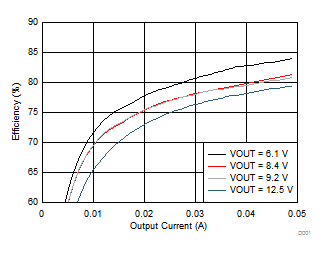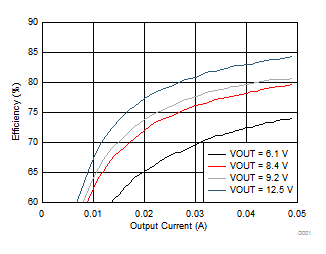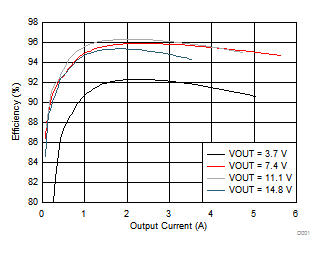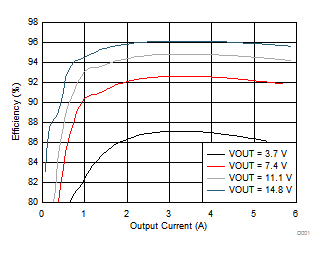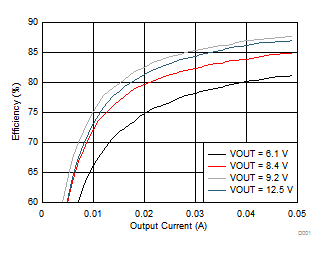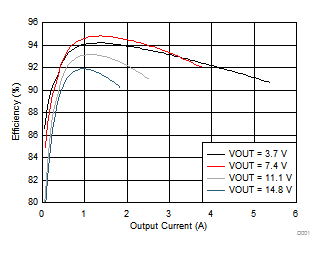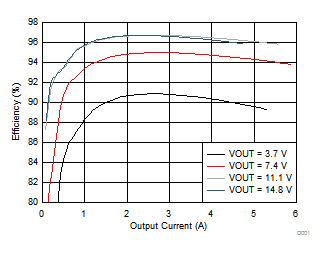| VINPUT_OP |
Input voltage operating range |
|
3.5 |
|
26 |
V |
| REGULATION ACCURACY |
| MAX SYSTEM VOLTAGE REGULATION |
| VSYSMAX_RNG |
System voltage regulation, measured on VSYS |
|
1.024 |
|
19.2 |
V |
| VSYSMAX_ACC |
System voltage regulation accuracy (charge disable) |
REG0x15() = 0x41A0H (16.800 V) |
|
VSRN + 160 mV |
|
V |
| –2% |
|
2% |
|
| REG0x15() = 0x3130H (12.592 V) |
|
VSRN + 160 mV |
|
V |
| –2% |
|
2% |
|
| REG0x15() = 0x20D0H (8.400 V) |
|
VSRN + 160 mV |
|
V |
| –3% |
|
3% |
|
| REG0x15() = 0x1060H (4.192 V) |
|
VSRN + 160 mV |
|
V |
| –3% |
|
3% |
|
| MINIMUM SYSTEM VOLTAGE REGULATION |
| VSYSMIN_RNG |
System voltage regulation, measured on VSYS |
|
1.024 |
|
19.2 |
V |
| VSYSMIN_REG_ACC |
Minimum system voltage regulation accuracy (charge enable, VBAT below REG0x3E() setting) |
REG0x3E() = 0x3000H |
|
12.288 |
|
V |
| –2% |
|
2% |
|
| REG0x3E() = 0x2400H |
|
9.216 |
|
V |
| –2% |
|
2% |
|
| REG0x3E() = 0x1800H |
|
6.144 |
|
V |
| –3% |
|
3% |
|
| REG0x3E() = 0x0E00H |
|
3.584 |
|
V |
| –3% |
|
4% |
|
| CHARGE VOLTAGE REGULATION |
| VBAT_RNG |
Battery voltage regulation |
|
1.024 |
|
19.2 |
V |
| VBAT_REG_ACC |
Battery voltage regulation accuracy (charge enable) (0°C to 85°C) |
REG0x15() = 0x41A0H |
|
16.8 |
|
V |
| –0.5% |
|
0.5% |
|
| REG0x15() = 0x3130H |
|
12.592 |
|
V |
| –0.5% |
|
0.5% |
|
| REG0x15() = 0x20D0H |
|
8.4 |
|
V |
| –0.6% |
|
0.6% |
|
| REG0x15() = 0x1060H |
|
4.192 |
|
V |
| –1.1% |
|
1.2% |
|
| CHARGE CURRENT REGULATION IN FAST CHARGE |
| VIREG_CHG_RNG |
Charge current regulation differential voltage range |
VIREG_CHG = VSRP – VSRN |
0 |
|
81.28 |
mV |
| ICHRG_REG_ACC |
Charge current regulation accuracy 10-mΩ current sensing resistor, VBAT above 0x3E() setting (0°C to 85°C) |
REG0x14() = 0x1000H |
|
4096 |
|
mA |
| –3% |
|
2% |
|
| REG0x14() = 0x0800H |
|
2048 |
|
mA |
| –4% |
|
3% |
|
| REG0x14() = 0x0400H |
|
1024 |
|
mA |
| –5% |
|
5% |
|
| REG0x14() = 0x0200H |
|
512 |
|
mA |
| –12% |
|
12% |
|
| CHARGE CURRENT REGULATION IN LDO MODE |
| ICLAMP |
Pre-charge current clamp |
CELL 2s-4s |
|
384 |
|
mA |
| CELL 1 s, VSRN < 3 V |
|
384 |
|
mA |
| CELL 1 s, 3 V < VSRN < VSYS_MIN |
|
2 |
|
A |
| IPRECHRG_REG_ACC |
Pre-charge current regulation accuracy with 10-mΩ SRP/SRN series resistor, VBAT below REG0x3E() setting (0°C to 85°C) |
REG0x14() = 0x0180H |
|
384 |
|
mA |
| 2S-4S |
–15% |
|
15% |
|
| 1S |
–25% |
|
25% |
| REG0x14() = 0x0100H |
|
256 |
|
mA |
| 2S-4S |
–20% |
|
20% |
|
| 1S |
–35% |
|
35% |
| REG0x14() = 0x00C0H |
|
192 |
|
mA |
| 2S-4S |
–25% |
|
25% |
|
| 1S |
–50% |
|
50% |
| REG0x14() = 0x0080H |
|
128 |
|
mA |
| 2S-4S |
–30% |
|
30% |
|
| ILEAK_SRP_SRN |
SRP, SRN leakage current mismatch (0°C to 85°C) |
|
–12 |
|
–10 |
µA |
| INPUT CURRENT REGULATION |
| VIREG_DPM_RNG |
Input current regulation differential voltage range |
VIREG_DPM = VACP – VACN |
0.5 |
|
64 |
mV |
| IDPM_REG_ACC |
Input current regulation accuracy with 10-mΩ ACP/ACN series resistor (–40°C to 105°C) |
REG0x3F() = 0x4FFFH |
3820 |
|
4000 |
mA |
| REG0x3F() = 0x3BFFH |
2830 |
|
3000 |
mA |
| REG0x3F() = 0x1DFFH |
1350 |
|
1500 |
mA |
| REG0x3F() = 0x09FFH |
340 |
|
500 |
mA |
| ILEAK_ACP_ACN |
ACP, ACN leakage current mismatch |
|
–16 |
|
10 |
µA |
| VIREG_DPM_RNG_ILIM |
Voltage Range for input current regulation |
|
1 |
|
4 |
V |
| IDPM_REG_ACC_ILIM |
Input Current Regulation Accuracy on ILIM_HIZ pin VILIM_HIZ = 1 V + 40 × IDPM × RAC, with 10-mΩ ACP/ACN series resistor |
VILIM_HIZ = 2.6 V |
3800 |
4000 |
4200 |
mA |
| VILIM_HIZ = 2.2 V |
2800 |
3000 |
3200 |
mA |
| VILIM_HIZ = 1.6 V |
1300 |
1500 |
1700 |
mA |
| VILIM_HIZ = 1.2 V |
300 |
500 |
700 |
mA |
| ILEAK_ILIM |
ILIM_HIZ pin leakage |
|
–1 |
|
1 |
µA |
| INPUT VOLTAGE REGULATION |
| VIREG_DPM_RNG |
Input voltage regulation range |
Voltage on VBUS |
3.2 |
|
19.52 |
V |
| VDPM_REG_ACC |
Input voltage regulation accuracy |
REG0x3D()=0x3C80H |
|
18688 |
|
mV |
|
–2% |
|
2% |
|
| REG0x3D()=0x1E00H |
|
10880 |
|
mV |
|
–2.5% |
|
2.5% |
|
| REG0x3D()=0x0500H |
|
4480 |
|
mV |
|
–3% |
|
5% |
|
| REFERENCE AND BUFFER |
| REGN REGULATOR |
| VREGN_REG |
REGN regulator voltage (0 mA–60 mA) |
VVBUS = 10 V |
5.7 |
6 |
6.3 |
V |
| VDROPOUT |
REGN voltage in drop out mode |
VVBUS = 5 V, ILOAD = 20 mA |
3.8 |
4.3 |
4.6 |
V |
| IREGN_LIM_Charging |
REGN current limit when converter is enabled |
VVBUS = 10 V, force VREGN = 4 V |
50 |
65 |
|
mA |
| CREGN |
REGN output capacitor required for stability |
ILOAD = 100 µA to 50 mA |
2.2 |
|
|
µF |
| CVDDA |
REGN output capacitor required for stability |
ILOAD = 100 µA to 50 mA |
1 |
|
|
µF |
| QUIESCENT CURRENT |
| IBAT_BATFET_ON |
System powered by battery. BATFET on. ISRN + ISRP + ISW2+ IBTST2 + ISW1 + IBTST1+ ACP + IACN + IVBUS + IVSYS |
VBAT = 18 V, REG0x12[15] = 1, in low power mode |
|
22 |
45 |
µA |
| VBAT = 18 V, REG0x12[15] = 1, in low power mode, REG0x30[14:13] = 01, REGN off |
|
105 |
175 |
µA |
| VBAT=18 V, REG0x12[15] = 1, in low power mode, REG0x30[14:13]= 10, REGN off |
|
60 |
90 |
µA |
| VBAT = 18 V, REG0x12[15] = 0, REG0x30[12] = 0, REGN on, EN_PSYS |
|
860 |
1150 |
µA |
| VBAT = 18 V, REG0x12[15] = 0, REG0x30[12] = 1, REGN on |
|
960 |
1250 |
| IAC_SW_LIGHT_buck |
Input current during PFM in buck mode, no load, IVBUS + IACP + IACN + IVSYS + ISRP + ISRN + ISW1 + IBTST + ISW2 + IBTST2 |
VIN = 20 V, VBAT = 12.6 V, 3 s, REG0x12[10] = 0; MOSFET Qg = 4 nC |
|
2.2 |
|
mA |
| IAC_SW_LIGHT_boost |
Input current during PFM in boost mode, no load, IVBUS + IACP + IACN + IVSYS + ISRP + ISRN + ISW1 + IBTST2 + ISW2 + IBTST2 |
VIN = 5 V, VBAT = 8.4 V, 2 s, REG0x12[10] = 0; MOSFET Qg = 4 nC |
|
2.7 |
|
mA |
| IAC_SW_LIGHT_buckboost |
Input current during PFM in buck boost mode, no load, IVBUS + IACP + IACN + IVSYS + ISRP + ISRN + ISW1 + IBTST1 + ISW2 + IBTST2 |
VIN = 12 V, VBAT = 12 V, REG0x12[10] = 0; MOSFET Qg = 4 nC |
|
2.4 |
|
mA |
| VACP/N_OP |
Input common mode range |
Voltage on ACP/ACN |
3.8 |
|
26 |
V |
| VIADPT_CLAMP |
IADPT output clamp voltage |
|
3.1 |
3.2 |
3.3 |
V |
| IIADPT |
IADPT output current |
|
|
|
1 |
mA |
| AIADPT |
Input current sensing gain |
V(IADPT) / V(ACP-ACN), REG0x12[4] = 0 |
|
20 |
|
V/V |
| V(IADPT) / V(ACP-ACN), REG0x12[4] = 1 |
|
40 |
|
V/V |
| VIADPT_ACC |
Input current monitor accuracy |
V(ACP-ACN) = 40.96 mV |
–2% |
|
2% |
|
| V(ACP-ACN) = 20.48 mV |
–3% |
|
3% |
|
| V(ACP-ACN) =10.24 mV |
–6% |
|
6% |
|
| V(ACP-ACN) = 5.12 mV |
–10% |
|
10% |
|
| CIADPT_MAX |
Maximum output load capacitance |
|
|
|
100 |
pF |
| VSRP/N_OP |
Battery common mode range |
Voltage on SRP/SRN |
2.5 |
|
18 |
V |
| VIBAT_CLAMP |
IBAT output clamp voltage |
|
3.1 |
3.2 |
3.3 |
V |
| IIBAT |
IBAT output current |
|
|
|
1 |
mA |
| AIBAT |
Charge and discharge current sensing gain on IBAT pin |
V(IBAT) / V(SRN-SRP), REG0x12[3] = 0, |
|
8 |
|
V/V |
| V(IBAT) / V(SRN-SRP), REG0x12[3] = 1, |
|
16 |
|
V/V |
| IIBAT_CHG_ACC |
Charge and discharge current monitor accuracy on IBAT pin |
V(SRN-SRP) = 40.96 mV |
–2% |
|
2% |
|
| V(SRN-SRP) = 20.48 mV |
–3% |
|
4% |
|
| V(SRN-SRP) =10.24 mV |
–6% |
|
6% |
|
| V(SRN-SRP) = 5.12 mV |
–12% |
|
12% |
|
| CIBAT_MAX |
Maximum output load capacitance |
|
|
|
100 |
pF |
| SYSTEM POWER SENSE AMPLIFIER |
| VPSYS |
PSYS output voltage range |
|
0 |
|
3.3 |
V |
| IPSYS |
PSYS output current |
|
0 |
|
160 |
µA |
| APSYS |
PSYS system gain |
V(PSYS) / (P(IN)+ P(BAT)), REG0x30[9] = 1 |
|
1 |
|
µA/W |
| VPSYS_ACC |
PSYS gain accuracy (REG0x3B[9] = 1), TA = 25°C |
Adapter only with system power = 19.5 V / 45 W |
–5% |
|
5% |
|
| Battery only with system power 11 V / 44 W (25°C) |
–5% |
|
5% |
|
| VPSYS_CLAMP |
PSYS clamp voltage |
|
3 |
|
3.3 |
V |
| COMPARATOR |
| VBUS UNDER VOLTAGE LOCKOUT COMPARATOR |
| VVBUS_UVLOZ |
VBUS undervoltage rising threshold |
VBUS rising |
2.34 |
2.55 |
2.77 |
V |
| VVBUS_UVLO |
VBUS undervoltage falling threshold |
VBUS falling |
2.2 |
2.4 |
2.6 |
V |
| VVBUS_UVLO_HYST |
VBUS undervoltage hysteresis |
|
|
150 |
|
mV |
| VVBUS_CONVEN |
VBUS converter enable rising threshold |
VBUS rising |
3.2 |
3.5 |
3.9 |
V |
| VVBUS_CONVENZ |
VBUS converter enable falling threshold |
VBUS falling |
2.9 |
3.2 |
3.5 |
V |
| VVBUS_CONVEN_HYST |
VBUS converter enable hysteresis |
|
|
400 |
|
mV |
| BATTERY UNDER VOLTAGE LOCKOUT COMPARATOR |
| VVBAT_UVLOZ |
VBAT undervoltage rising threshold |
VSRN rising |
2.35 |
2.55 |
2.75 |
V |
| VVBAT_UVLO |
VBAT undervoltage falling threshold |
VSRN falling |
2.2 |
2.4 |
2.6 |
V |
| VVBAT_UVLO_HYST |
VBAT undervoltage hysteresis |
|
|
150 |
|
mV |
| BATTERY LOWV COMPARATOR (Pre-charge to Fast Charge Thresold for 1S) |
| VBATLV_FALL |
BATLOWV falling threshold |
1 s |
|
2.80 |
|
V |
| VBATLV_RISE |
BATLOWV rising threshold |
|
|
3.00 |
|
V |
| VBATLV_RHYST |
BATLOWV hysteresis |
|
|
200 |
|
mV |
| INPUT OVER-VOLTAGE COMPARATOR (ACOVP) |
| VACOV_RISE |
VBUS overvoltage rising threshold |
VBUS rising |
25 |
26 |
27 |
V |
| VACOV_FALL |
VBUS overvoltage falling threshold |
VBUS falling |
24 |
24.5 |
25 |
V |
| VACOV_HYST |
VBUS overvoltage hysteresis |
|
|
1.5 |
|
V |
| tACOV_RISE_DEG |
VBUS overvoltage rising deglitch |
VBUS rising to stop converter |
|
100 |
|
µs |
| tACOV_FALL_DEG |
VBUS overvoltage falling deglitch |
VBUS falling to start converter |
|
1 |
|
ms |
| INPUT OVER CURRENT COMPARATOR (ACOC) |
| VACOC |
ACP to ACN rising threshold, w.r.t. ILIM2 in REG0x33[15:11] |
Voltage across input sense resistor rising, Reg0x31[2] = 1 |
195% |
210% |
225% |
|
| VACOC_FLOOR |
Measure between ACP and ACN |
Set IDPM to minimum |
44 |
50 |
56 |
mV |
| VACOC_CEILING |
Measure between ACP and ACN |
Set IDPM to maximum |
172 |
180 |
188 |
mV |
| tACOC_DEG_RISE |
Rising deglitch time |
Deglitch time to trigger ACOC |
|
250 |
|
µs |
| tACOC_RELAX |
Relax time |
Relax time before converter starts again |
|
250 |
|
ms |
| SYSTEM OVER-VOLTAGE COMPARATOR (SYSOVP) |
| VSYSOVP_RISE |
System overvoltage rising threshold to turn off converter |
1 s |
4.85 |
5 |
5.1 |
V |
| 2 s |
11.7 |
12 |
12.2 |
V |
| 3s |
18 |
18.5 |
19 |
V |
| VSYSOVP_FALL |
System overvoltage falling threshold |
1 s |
|
4.8 |
|
V |
| 2 s |
|
11.5 |
|
V |
| 3s |
|
18 |
|
V |
| ISYSOVP |
Discharge current when SYSOVP stop switching was triggered |
on SYS |
|
20 |
|
mA |
| BAT OVER-VOLTAGE COMPARATOR (BATOVP) |
| VBATOVP_RISE |
Overvoltage rising threshold as percentage of VBAT_REG in REG0x15() |
1 s, 4.2 V |
102.5% |
104% |
105.7% |
|
| 2 s - 4 s |
102.5% |
104% |
105% |
|
| VBATOVP_FALL |
Overvoltage falling threshold as percentage of VBAT_REG in REG0x15() |
1 s |
100% |
102% |
104% |
|
| 2 s - 4 s |
100% |
102% |
103% |
|
| VBATOVP_HYST |
Overvoltage hysteresis as percentage of VBAT_REG in REG0x15() |
1 s |
|
2% |
|
|
| 2 s - 4 s |
|
2% |
|
|
| IBATOVP |
Discharge current during BATOVP |
on SRP and SRN |
|
20 |
|
mA |
| tBATOVP_RISE |
Overvoltage rising deglitch to turn off BATDRV to disable charge |
|
|
20 |
|
ms |
| CONVERTER OVER-CURRENT COMPARATOR (Q2) |
| VOCP_limit_Q2 |
Converter Over-Current Limit |
Reg0x31[5]=1 |
|
150 |
|
mV |
| Reg0x31[5]=0 |
|
210 |
|
| VOCP_limit_SYSSHORT_Q2 |
System Short or SRN<2.5 V |
Reg0x31[5]=1 |
|
45 |
|
mV |
| Reg0x31[5]=0 |
|
60 |
|
| CONVERTER OVER-CURRENT COMPARATOR (ACX) |
| VOCP_limit_ACX |
Converter Over-Current Limit |
Reg0x31[4]=1 |
|
150 |
|
mV |
| Reg0x31[4]=0 |
|
280 |
|
| VOCP_limit_SYSSHORT_ ACX |
System Short or SRN<2.5 V |
Reg0x31[4]=1 |
|
90 |
|
mV |
| Reg0x31[4]=0 |
|
150 |
|
| THERMAL SHUTDOWN COMPARATOR |
| TSHUT_RISE |
Thermal shutdown rising temperature |
Temperature increasing |
|
155 |
|
°C |
| TSHUTF_FALL |
Thermal shutdown falling temperature |
Temperature reducing |
|
135 |
|
°C |
| TSHUT_HYS |
Thermal shutdown hysteresis |
|
|
20 |
|
°C |
| tSHUT_RDEG |
Thermal shutdown rising deglitch |
|
|
100 |
|
µs |
| tSHUT_FHYS |
Thermal shutdown falling deglitch |
|
|
12 |
|
ms |
| VSYS PROCHOT COMPARATOR |
| VSYS_PROCHOT |
VSYS threshold falling threshold |
Reg0x36[7:6] = 00, 1 s |
|
2.85 |
|
V |
| Reg0x36[7:6] = 00, 2–4 s |
|
5.75 |
|
V |
| Reg0x36[7:6] = 01, 1 s |
2.95 |
3.1 |
3.25 |
V |
| Reg0x36[7:6] = 01, 2–4 s |
5.8 |
5.95 |
6.1 |
V |
| Reg0x36[7:6] = 10, 1 s |
|
3.3 |
|
V |
| Reg0x36[7:6] = 10, 2–4 s |
|
6.25 |
|
V |
| Reg0x36[7:6] = 11, 1 s |
|
3.5 |
|
V |
| Reg0x36[7:6] = 11, 2–4 s |
|
6.5 |
|
V |
| tSYS_PRO_RISE_DEG |
VSYS rising deglitch for throttling |
|
|
8 |
|
µs |
| ICRIT PROCHOT COMPARATOR |
| VICRIT_PRO |
Input current rising threshold for throttling as percentage above ILIM2 (REG0x33[15:11]) |
Reg0x36[15:11] = 00000 |
105% |
110% |
116% |
|
| Reg0x36[15:11] = 01001 |
142% |
150% |
155% |
|
| Reg0x36[15:11] = 11110 |
410% |
430% |
455% |
|
| INOM PROCHOT COMPARATOR |
| VINOM_PRO |
INOM rising threshold as percentage of IIN (REG0x3F()) |
|
105% |
110% |
116% |
|
| IDCHG PROCHOT COMPARATOR |
| VIDCHG_PRO |
IDCHG threshold for throttling for IDSCHG of 6 A |
Reg0x38 [15:10]=001100 |
|
6144 |
|
mA |
| 95% |
|
102% |
|
| INDEPENDENT COMPARATOR |
| VINDEP_CMP |
Independent comparator threshold |
Reg0x30[7] = 1, CMPIN falling |
1.17 |
1.2 |
1.23 |
V |
| Reg0x30[7] = 0, CMPIN falling |
2.27 |
2.3 |
2.33 |
V |
| VINDEP_CMP_HYS |
Independent comparator hysteresis |
Reg0x06[6] = 0, CMPIN falling |
|
100 |
|
mV |
| POWER MOSFET DRIVER |
| PWM OSCILLATOR AND RAMP |
| FSW |
PWM switching frequency |
Reg0x00[9] = 0 |
1020 |
1200 |
1380 |
kHz |
| Reg0x00[9] = 1 |
680 |
800 |
920 |
kHz |
| BATFET GATE DRIVER (BATDRV) |
| VBATDRV_ON |
Gate drive voltage on BATFET |
|
8.5 |
10 |
11.5 |
V |
| VBATDRV_DIODE |
Drain-source voltage on BATFET during ideal diode operation |
|
|
30 |
|
mV |
| RBATDRV_ON |
Measured by sourcing 10-µA current to BATDRV |
|
3 |
4 |
6 |
kΏ |
| RBATDRV_OFF |
Measured by sinking 10-µA current from BATDRV |
|
|
1.2 |
2.1 |
kΏ |
| PWM HIGH SIDE DRIVER (HIDRV Q1) |
| RDS_HI_ON_Q1 |
High side driver (HSD) turnon resistance |
VBTST1 – VSW1 = 5 V |
|
6 |
|
Ω |
| RDS_HI_OFF_Q1 |
High side driver turnoff resistance |
VBTST1 – VSW1 = 5 V |
|
1.3 |
2.2 |
Ω |
| VBTST1_REFRESH |
Bootstrap refresh comparator falling threshold voltage |
VBTST1 – VSW1 when low side refresh pulse is requested |
3.2 |
3.7 |
4.6 |
V |
| PWM HIGH SIDE DRIVER (HIDRV Q4) |
| RDS_HI_ON_Q4 |
High side driver (HSD) turnon resistance |
VBTST2 – VSW2 = 5 V |
|
6 |
|
Ω |
| RDS_HI_OFF_Q4 |
High side driver turnoff resistance |
VBTST2 – VSW2 = 5 V |
|
1.5 |
2.4 |
Ω |
| VBTST2_REFRESH |
Bootstrap refresh comparator falling threshold voltage |
VBTST2 – VSW2 when low side refresh pulse is requested |
3.3 |
3.7 |
4.6 |
V |
| PWM LOW SIDE DRIVER (LODRV Q2) |
| RDS_LO_ON_Q2 |
Low side driver (LSD) turnon resistance |
VBTST1 – VSW1 = 5.5 V |
|
6 |
|
Ω |
| RDS_LO_OFF_Q2 |
Low side driver turnoff resistance |
VBTST1 – VSW1 = 5.5 V |
|
1.7 |
2.6 |
Ω |
| PWM LOW SIDE DRIVER (LODRV Q3) |
| RDS_LO_ON_Q3 |
Low side driver (LSD) turnon resistance |
VBTST2 – VSW2 = 5.5 V |
|
7.6 |
|
Ω |
| RDS_LO_OFF_Q3 |
Low side driver turnoff resistance |
VBTST2 – VSW2 = 5.5 V |
|
2.9 |
4.6 |
Ω |
| INTERNAL SOFT START During Charge Enable |
| SSSTEP_DAC |
Soft Start Step Size |
|
|
64 |
|
mA |
| SSSTEP_DAC |
Soft Start Step Time |
|
|
8 |
|
µs |
| INTEGRATED BTST DIODE (D1) |
| VF_D1 |
Forward bias voltage |
IF = 20 mA at 25°C |
|
0.8 |
|
V |
| VR_D1 |
Reverse breakdown voltage |
IR = 2 µA at 25°C |
|
|
20 |
V |
| INTEGRATED BTST DIODE (D2) |
| VF_D2 |
Forward bias voltage |
IF = 20 mA at 25°C |
|
0.8 |
|
V |
| VR_D2 |
Reverse breakdown voltage |
IR = 2 µA at 25°C |
|
|
20 |
V |
| PWM DRIVERS TIMING |
| INTERFACE |
| LOGIC INPUT (SDA, SCL) |
| VIN_ LO |
Input low threshold |
SMBus |
|
|
0.8 |
V |
| VIN_ HI |
Input high threshold |
SMBus (bq25708) |
2.1 |
|
|
V |
| LOGIC OUTPUT OPEN DRAIN (SDA, CHRG_OK, CMPOUT) |
| VOUT_ LO |
Output saturation voltage |
5-mA drain current |
|
|
0.4 |
V |
| VOUT_ LEAK |
Leakage current |
V = 7 V |
–1 |
|
1 |
mA |
| LOGIC OUTPUT OPEN DRAIN SDA |
| VOUT_ LO_SDA |
Output Saturation Voltage |
5 mA drain current |
|
|
0.4 |
V |
| VOUT_ LEAK_SDA |
Leakage Current |
V = 7V |
–1 |
|
1 |
mA |
| LOGIC OUTPUT OPEN DRAIN CHRG_OK |
| VOUT_ LO_CHRG_OK |
Output Saturation Voltage |
5 mA drain current |
|
|
0.4 |
V |
| VOUT_ LEAK _CHRG_OK |
Leakage Current |
V = 7V |
–1 |
|
1 |
mA |
| LOGIC OUTPUT OPEN DRAIN CMPOUT |
| VOUT_ LO_CMPOUT |
Output Saturation Voltage |
5 mA drain current |
|
|
0.4 |
V |
| VOUT_ LEAK _CMPOUT |
Leakage Current |
V = 7V |
–1 |
|
1 |
mA |
| LOGIC OUTPUT OPEN DRAIN (PROCHOT) |
| VOUT_ LO_PROCHOT |
Output saturation voltage |
50-Ω pullup to 1.05 V / 5-mA load |
|
|
300 |
mV |
| VOUT_ LEAK_PROCHOT |
Leakage current |
V = 5.5 V |
–1 |
|
1 |
mA |
| ANALOG INPUT (ILIM_HIZ) |
| VHIZ_ LO |
Voltage to get out of HIZ mode |
ILIM_HIZ pin rising |
0.8 |
|
|
V |
| VHIZ_ HIGH |
Voltage to enable HIZ mode |
ILIM_HIZ pin falling |
|
|
0.4 |
V |
| ANALOG INPUT (CELL_BATPRESZ) |
| VCELL_4S |
4S |
REGN = 6 V, as percentage of REGN |
68.4% |
75% |
|
|
| VCELL_3S |
3s |
REGN = 6 V, as percentage of REGN |
51.7% |
55% |
65% |
|
| VCELL_2S |
2S |
REGN = 6 V, as percentage of REGN |
35% |
40% |
49.1% |
|
| VCELL_1S |
1S |
REGN = 6 V, as percentage of REGN |
18.4% |
25% |
31.6% |
|
| VCELL_BATPRESZ_RISE |
Battery is present |
|
18% |
|
|
|
| VCELL_BATPRESZ_FALL |
Battery is removed |
CELL_BATPRESZ falling |
|
|
15% |
|
| ANALOG INPUT (COMP1, COMP2) |
| ILEAK_COMP1 |
COMP1 Leakage |
|
–120 |
|
120 |
nA |
| ILEAK_COMP2 |
COMP2 Leakage |
|
–120 |
|
120 |
nA |
